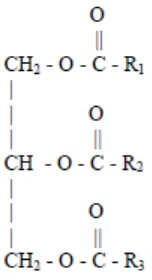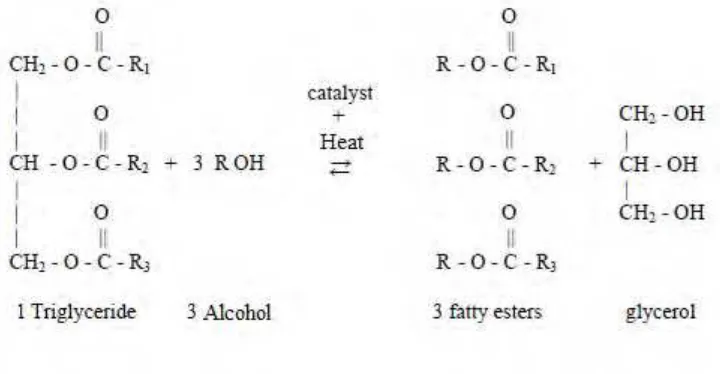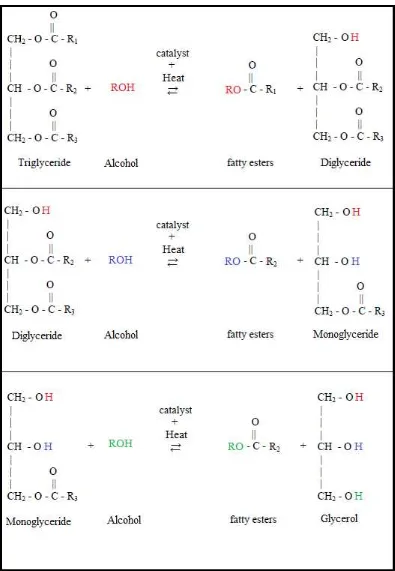PROCESS OPTIMIZATION FOR ESTERIFICATION FROM NON-EDIBLE RUBBER SEED
LOH HAO ZHE
UNIVERSITI TEKNIKAL MALAYSIA MELAKA
LO H H A O Z H E BACH EL O
R OF MECH
SUPERVISOR DECLARATION
“I hereby declare that I have read this thesis and in my opinion this thesis is sufficient in terms of scope and quality for the award of the degree of Bachelor of Mechanical Engineering (Thermal-Fluids)”
PROCESS OPTIMIZATION FOR ESTERIFICATION FROM NON-EDIBLE RUBBER SEED
LOH HAO ZHE
This thesis is submitted to Faculty of Mechanical Engineering as a requirement to get award of
Degree of Mechanical Engineering (Thermal-Fluids)
Faculty of Mechanical Engineering Universiti Teknikal Malaysia Melaka
DECLARATION
“I hereby declare that the work in this thesis is my own except for summaries and quotations which have been duly acknowledged.”
Signature : ……… Author : LOH HAO ZHE
ACKNOWLEDGEMENT
I would like to express my sincere appreciation to my FYP supervisor, Pn. Nor Faizah binti Haminudin for the guidance, teaching, encouragement and advisement. Without her supervision, guidance and trust, I will not be able to conduct the FYP successfully. Her assistance helps uncovering a multitude of errors and mistakes on my work.
I am also wish to express my appreciation to the members of Committee FYP for providing the information about the FYP. I would like to thank Engr. Dr. Md Fahmi bin Abd Samad @ Mahmood who conducted the FYP talk. I wish to thank my FYP panels for willing spends time for the evaluation.
I would also like to take this opportunity to thank the other group members. They have accompanied me along the conduction of FYP. We learned the knowledge together and shared useful information among each other. We worked as a team to discuss the projects together. We helped each other when someone having a problem.
I would also like to thank my form 6 chemistry teacher, Pn. Liew Chee Mooi for sharing her valuable knowledge in the field of chemistry. Without her help and support, the projects might not be success.
ABSTRAK
ABSTRACT
TABLE OF CONTENTS
Page
ACKNOWLEDGEMENTS i
ABSTRACT ii
TABLE OF CONTENTS iv
LIST OF FIGURES vii
LIST OF TABLES ix
LIST OF SYMBOLS x
LIST OF ABBREVIATION xi
1. INTRODUCTION
1.1. BIODIESEL 1
1.2. PROBLEM STATEMENT 3
1.3. OBJECTIVES 4
1.4. SCOPES 4
2. LITERATURE REVIEW
2.1. METHOD OF BIODIESEL PRODUCTION 5
2.2. CHEMISTRY IN BIODIESEL PRODUCTION
2.2.1. Chemical Formula of Feedstock Oil 6
2.2.2. Transesterification 7
2.2.3. Esterification 10
2.2.4. Hydrolysis 11
2.2.5. Saponification 12
2.2.6. Separation Process 13
2.3. CATALYST 14
2.3.1. Homogeneous Catalyst 16
2.3.2. Heterogeneous Catalyst 16
2.4.1. Vegetable Oil 18
2.4.2. Palm Oil 18
2.4.3. Waste Cooking Oil 19
2.4.4. Jatropha 20
2.4.5. Rubber Seed Oil 20
2.5. CONVENTIONAL METHOD FOR BIODIESEL PRODUCTION 23
2.6. BIODIESEL PROPERTIES
2.6.1. Cetane Number 24
2.6.2. Cloud point and pour point 25
2.6.3. Water Content 25
2.6.4. Flash Point 26
2.6.5. Viscosity 27
2.6.6. Acid value (or Acid number) 28
2.6.7. Sulphur content 28
2.7. FACTORS AFFECTING TRANSESTERIFICATION
REACTION
2.7.1. Moisture Content 29
2.7.2. Free Fatty Acid Content 29
2.7.3. Molar ratio of alcohol to triglyceride 29
2.7.4. The effect of reaction time 30
2.7.5. The effect of reaction temperature 31
2.7.6. Effect of catalyst concentration 31
2.8. OPTIMIZATION OF ESTERIFICATION 32
2.8.1. Response Surface Methodology (RSM) 32
2.8.2. Analysis of Variance (ANOVA) 33
3. METHODOLOGY 35
3.1. TESTING FOR OIL PROPERTIES 35
3.1.1. Density 36
3.1.2. Acid Value 38
3.1.3. Kinematic Viscosity 39
3.1.4. Saponification Number 40
3.1.5. Iodine Value 41
3.3. TWO STAGE TRANSESTERIFICATION PROCESS 45
3.3.1. Acid-Catalyzed Esterification Process 45
3.3.2. Base-Catalyzed Transesterification Process 46
4. RESULT AND DISCUSSION
4.1. CRUDE OIL PROPERTIES 48
4.1.1. Pre-Test of Crude Oil Properties 48
4.1.2. Gas Chromatography 49
4.2. ESTERIFICATION RESULT 50
4.3. ANALYSIS OF VARIANCE (ANOVA) 51
4.4. EFFECT OF FACTORS ON ESTERIFICATION
4.4.1. Main Effect of Methanol to Oil Ratio 53
4.4.2. Main Effect of Catalyst Concentration 54
4.4.3. Main Effect of Reaction Time 54
4.4.4. Combination Effect of Methanol to Oil Ratio and 55
Catalyst Concentration
4.4.5. Combine Effect of Methanol to Oil Ratio and Reaction Time 57 4.4.6. Combine Effect of Catalyst Concentration and Reaction Time 58
4.5. OPTIMIZATION OF PARAMETERS 60
4.6. TRANSESTERIFICATION RESULT 60
4.7. PROPERTIES OF BIODIESEL 60
5. DISCUSSION 62
5.1.APPARATUS CONSTRAINT 62
5.2.VISCOUS EFFECT ON SEPARATING PROCESS 63
5.3.EMULSION 64
5.4.HYDRATE GUM 64
6. CONCLUSION AND RECOMMENDATION
6.1. CONCLUSION 66
6.2. RECOMMENDATION 66
REFERENCES 68
LIST OF FIGURES
No. Title Page
2.1 The schematic configuration of triglyceride molecules exist in vegetable oils or animal fats.
6
2.2 The schematic configuration of fatty acids in free form. 6
2.3 The overall chemical equation of transesterification process. 7
2.4 The steps involve in the transesterification reaction. 8
2.5 The chemical equation of esterification process. 10
2.6 The chemical equation of hydrolysis of triglyceride into FFA and
diglyceride.
11
2.7 The chemical equation of saponification in ester, FFA and
triglyceride
12
2.8 The separation process of the mixture according to the density of the substances.
14
2.9 The mechanism of conventional heating 23
3.1 The pycnometer filled with oil. 36
4.1 The main effects plot of methanol to oil ratio on the %FFA of RSO. 53
4.2 The main effects plot of catalyst concentration on the %FFA of
RSO.
54
4.3 The main effects plot of reaction time on the %FFA of RSO. 55
4.4 Two dimensional contour plots of %FFA against methanol to oil
ratio and catalyst concentration when reaction time is keep constant at 0 (coded value) or 72.5 minutes (actual value).
56
4.5 Three dimensional surface plots of %FFA against methanol to oil
ratio and catalyst concentration when reaction time is keep constant at 0 (coded value) or 72.5 minutes (actual value).
and reaction time when catalyst concentration is keep constant at 0 (coded value) or 7.5 wt% (actual value).
4.7 Three dimensional surface plot of %FFA against methanol to oil
ratio and reaction time when catalyst concentration is keep constant at 0 (coded value) or 7.5 wt% (actual value).
58
4.8 Two dimensional contour plot of %FFA against catalyst
concentration and reaction time when methanol to oil ratio is keep constant at 0 (coded value) or 12.5 in molar ratio (actual value).
59
4.9 Three dimensional surface plot of %FFA against catalyst
concentration and reaction time when methanol to oil ratio is keep constant at 0 (coded value) or 12.5 in molar ratio (actual value).
59
5.1 The modified apparatus setup. 63
5.2 Some of the substances adhesive on the inner surface of the separating funnel.
63
5.3 The emulsion formed between the two layers during washing
process.
64
LIST OF TABLES
No. Title Page
2.1 The properties of the substances that influence the separation process. 13
2.2 Advantages and disadvantages of the main biodiesel
transesterification methods
15
2.3 List of biodiesel feedstock 17
2.4 The properties of waste cooking oil 19
2.5 The comparison of properties of rubber seed oil and diesel according
to ASTM test standard
21
2.6 Physiochemical properties of crude oil and refined (bleached) rubber
seed oil
21
2.7 The comparison of yields of ester-fuel (weight per cent) from crude oil and refined oil
22
2.8 Properties biodiesel in comparison with standard biodiesel and diesel 22
3.1 The value of density of distilled water at varies temperature 36
3.2 The tabulated result of the density test 37
3.3 Coded and real values of the selected factors in DOE 43
3.4 19 experiment runs is designed with CCD method. 44
4.1 The pre-test result of the crude RSO. 48
4.2 The composition of fatty acids in the crude RSO from gas
chromatography result.
49
4.3 The mean molecular weight of crude RSO 50
4.4 The experimental result and predicted result of %FFA . 50
4.5 The model summary of the response surface regression. 51
4.6 The ANOVA for the full quadratic model. 52
4.7 The parameters using in transesterification process. 60
LIST OF SYMBOLS
ᵒC = Degree Celsius
g = Gram
g/cm3 = Gram per cubic centimeter
mPa•s = Millipascal second
ml = Millilitre
N = Normality
cP = Centipoise
g/mol = Gram per mole
mol/L = Mole per litre
T = Temperature
V = Volume
m = Mass
ρ = Density
α = Distance for axial runs
R2 = Coefficient of determination
%FFA = Percentage of Free Fatty Acid content
wt% = Weight percent
x = Mass Fraction
Mr = Molecular weight
x1 = Molar ratio of methanol to oil
x2 = Catalyst concentration
x3 = Reaction time
LIST OF ABBREVIATION
ANOVA = Analysis of Variance
ASTM = American Society for Testing and Materials
AV = Acid Value
BBD = Box-Behnken Design
CCD = Central Composite Design
DOE = Design of Experiment
FAEE = Fatty Acid Ethyl Ester
FAME = Fatty Acid Methyl Ester
FFA = Free Fatty Acid
FYP = Final Year Project
IV = Iodine Value
RSM = Response Surface Methodology
CHAPTER 1
INTRODUCTION
1.1 BIODIESEL
The steady supply of energy is the essential part for a modern lifestyle, where people use the energy for varies application in daily activity. The major world’s energy supplies are from fossil fuels and nuclear energy. Fossil fuel is the largest contributor to the transportation fuel. Energy sources can be categorized as renewable or nonrenewable energy. The fossil fuels are able to be formed naturally by the decay of the dead organisms, but the process takes over millions of years. Since traditional fossil fuel resources are being depleted and in addition, the consumption of energy is growing rapidly, the renewable energy is currently receiving increased attention (Muley, 2008).
The utilization of the fossil fuels bring the negative impact to the environment which is emission of carbon dioxide and other harmful gases such as sulphur oxides, nitrogen oxides, carbon monoxide, and ash deposition (Muley, 2008). The combustion of fossil fuels produces 21.3 billion tons of carbon dioxide per year (Annual, 2007). The advantages of the biodiesel are low emissions, biodegradable, nontoxic, and also better lubricant compare to fossil fuel (Lam et al., 2010; Wan Omar & Saidina Amin, 2011). Biodiesel is safer to handle and store due to its high flash point.
The first concept of using vegetable oil as a fuel resource was in 1895. The first diesel engine that runs with vegetable oil was designed by Rudolf Diesel in 1900. In 1912, Rudolf Diesel declared that the use of vegetable oils as engine fuels may seem insignificant during that time, but he predicted that the biodiesel may become as important as petroleum and the coal tar products in the future (Ahmad et al., 2012). Vegetable oils were used as diesel fuels from time to time in the 1930s and 1940s, but usually only in emergency situations.
Energy is an essential element for the development of civilizations. Fossil fuel as a non-renewable energy source is the primary and leading energy source and majorly consumed by the transport sector (Batidzirai et al., 2012). The depletion of fossil fuel resources and the increasing in fuel consumption lead to continuous rise in petroleum oil prices (Zabeti et al., 2009). Furthermore, the utilization of fossil fuels also causes degradation of environment quality (Kanwal, 2012). These have focused attention on using alternative energy sources such as biodiesel which is a renewable energy source, to replace fossil fuels as the transportation fuels.
Biodiesel is an ideal replacement for the fossil fuel as the transportation fuel. However, there is some obstacles and challenge in biodiesel production. The current cost of the biodiesel production is very high, which is 1.5 times higher than that of petroleum-based diesel production (Lin et al., 2012). Biodiesel production from edible feedstock results high production cost and food crisis, due to the demand for human consumption (Satyanarayanareddy & Regupathi, n.d.; Patil et al., 2012).
The main factor that reduces the yield of biodiesel production is the soap formation from saponification process. The high free fatty acid content in rubber seed oil would react with alkaline catalyst to produce soap during transesterification process. Soap formed would hinder the separation process and causes emulsion.
1.3 OBJECTIVES
The objectives of this study are:
1. To explore and examines the potential biodiesel production from non-edible Rubber Seed Oil (RSO).
2. To optimize esterification parameters by using design of experiment (DOE). 3. To analysis and compare the physical properties of biodiesel fuel with standard
diesel.
1.4 SCOPES
The scopes covered in this study are:
1. Conducting experiment of biodiesel production using RSO
2. Optimization of esterification parameters using Response Surface Methodology (RSM)
3. Study factor parameters and variables effected biodiesel synthesis and esterification reaction
CHAPTER 2
LITERATURE REVIEW
2.1 METHOD OF BIODIESEL PRODUCTION
Biodiesel can be produced in four main methods, which are direct use and blending, microemulsion, thermal cracking (pyrolysis) and transesterification. Transesterification is the most common methods due to its relatively simple procedure and cost-effective production. Besides that, transesterification can also lower the viscosity of the biodiesel and produces glycerol as a by-product which has extra commercial value (Hoque & Gee, 2013).
2.2 CHEMISTRY IN BIODIESEL PRODUCTION
2.2.1 Chemical Formula of Feedstock Oil
[image:21.595.282.358.239.379.2]All vegetable oils and animal fats consist primarily of triglyceride molecules which has the schematic configuration as shown in Figure 2.1, where R1, R2, and R3 represent the hydrocarbon chains of the fatty acyl groups of the triglyceride.
Figure 2.1: The schematic configuration of triglyceride molecules exist in vegetable oils or animal fats (Gerpen et al., 2004).
The fatty acids in free form have the configuration as shown in Figure 2.2, where R is a hydrocarbon chain equal or higher than 10 carbon atoms.
Transesterification is a reaction process of a triglyceride molecule with an excess of alcohol in the presence of a catalyst to produce glycerol and fatty esters (Gerpen et al., 2004). The chemical reaction of triglyceride molecule with alcohol is shown schematically as in the Figure 2.3. The reaction is reversible and hence excess alcohol is used to ensure the equilibrium shift on right hand side, which increases the yield of fatty esters (Muley, 2008).
Figure 2.3: The overall chemical equation of transesterification process.
connected by glycerol. During the transesterification process, the bonds are broken by hydrolyzing them to form free fatty acids. These fatty acids are then mixed or reacted with methanol or ethanol forming methyl or ethyl fatty acid esters (monocarbon acid esters). The mixture separates and settles out leaving the glycerol on the bottom and the biodiesel (methyl ester, ethyl ester) on the top. In order to avoid reversed reaction, the separation of these two substances has to be conducted completely and quickly. The transesterification reactions are often conducted with the presence of acid or base catalyst (Rutz, 2008). Furthermore, if alkaline catalyst is used in transesterification process, the reactant must be free from water because water content initiate saponification. This makes the transesterification reaction partially change to saponification.
The common alcohols used in the transesterification process are mainly methanol and ethanol while higher or secondary alcohols are also available. The advantages of methanol are readily available, higher reactivity and low cost, thus it is widely used. Methanol can be obtained from renewable sources, however it is highly toxic which is a major problem. Ethanol provides better solubility for oil than methanol. It also can be obtained from renewable agricultural resources. Ethanol can produce ethyl esters with higher heat content and cetane number during transesterification process. The disadvantage is the hydrophilic nature of ethanol, having a tendency to mix with or dissolve in water, which requires proper storage (Demirbas, 2008).
The most commonly method for biodiesel production is transesterification with methanol, also called methanolysis. The solubility of methanol in vegetable oil is relatively low, so it is necessary to mix all ingredients well. The product of biodiesel yield from methanolysis is fatty acid methyl ester(FAME) (Rutz, 2008).


